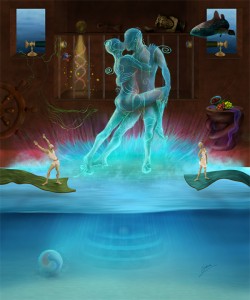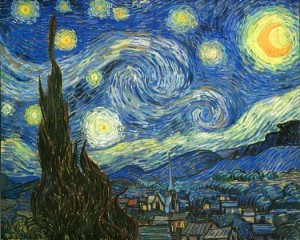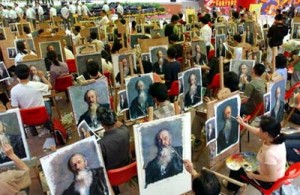The cliché of a Poor Artist
The cliche of a poor artist. It’s charming, isn’t it. Such noble souls are artists, they break their backs, pour their souls into their art, leave something for all of humankind and eternity and are utterly satisfied with peanuts in return.
“This painting took you one month to paint? Let’s see… about XYZ Euros is a decent salary. Your painting shouldn’t be worth more than that, otherwise you are just being greedy.”
We all know that greedy isn’t noble.
Never mind when you get those XYZ Euros or how long it took you to get them. Who cares that an artist doesn’t get a fix monthly salary. Never mind that you don’t paint from 8am to 5pm and then forget about it, never mind that your painting is a piece of you and you are offering something uniquely irreplaceable. Perhaps they’ll erect a museum in your honor a hundred years from now, or name a street after you. Your art will then be worth a hundred or thousand times what it is now, but that’s beside the point. Such perversions can be summarized as the ridiculousness of the art world at large and should have nothing to do with the artist as an individual.
The artist, as an individual and while alive, should be happy if their art is appreciated. That is all the food the proper artist should require.
Who cares if the artist has a family, bills, responsibilities, people to take care of. They shouldn’t, they can’t, because – after all – the cliché of an artist is a highly irresponsible individual, absorbed by their art and oblivious to all other worldly matters.
I used to paint in oil, sometimes acrylics. I eventually concluded that what my paintings are worth to me is seen as overpriced, at least by the masses and since I do want to reach people and not merely a few interested individuals, what to do?
As I’ve always, within reason, liked to experiment and try out new things I thought I’d give a new medium a try. A medium that allows me to paint in the same way as before, but realize my ideas slightly faster. I decided to focus on selling my artworks as limited edition giclées.
How much for the first level?
 Holding the Primordial Tango in his hands, a man whose profession is to deal with paintings and art, says: “This is a remarkably beautiful painting. It is exactly the kind of art I like!”
Holding the Primordial Tango in his hands, a man whose profession is to deal with paintings and art, says: “This is a remarkably beautiful painting. It is exactly the kind of art I like!”
He is obviously excited and admires the painting with great pleasure. I am happy he likes it that much.
“How much does it cost?”, he asks. I raise my eyebrows and smile, he nods and adds “I know it's always so difficult for artists to price their art.”
“Yes, it is,” I reply. “Well, that's the first giclée out of a limited edition of hundred.” I explain while watching him turn the painting around to see its back.
“I see that now,” he says, noticing the numbering on the back of the canvas.
I proceed to tell him the price. Still holding the painting in his hands, not taking his eyes off it, he asks “How much for the first level?”
“The first level?” I have no idea what he means.
“The first level. The original. The oil. How much for the oil painting?”
“Oh… it wasn’t painted in oil, it is digital, so the giclée is in this case as original as it gets.”
Now he is completely amazed, “But this looks completely like an oil painting!”, he exclaims.
“Yes, I've been told that before. That's probably because of how I paint them. I don't use any digital tools or filters or anything like that. It's all hand-painted, just like my oils are. It's just a different medium.”, and I proceed to explain my process in a bit more detail since he seems interested.
“This is really an exceptional quality for a giclée,” he concludes. He is used to seeing giclées as secondary copies of the first level originals so now that is what he sees.
How can you claim to love surrealism, which shook up the foundations of the art scene, and art of imagination but not appreciate a new medium and a new & bold way of creating art?
Doesn’t matter, moving on. Regardless of how it ended, this conversation made me wonder about the importance of things deemed important when it comes to art. It made me wonder about the importance of a medium, the value of a print. Holding a painting in his hands, the man thought it’s an original oil painting, and he was not the first one either. That seems to be the level of quality and the overall impression my paintings make, yet the new medium still throws some people off.
The myth called oil, the myth called print
If I draw a picture, using ink, it is a valuable and unique original piece of art.
If I run the same picture through the printer – mind you, a printer which also uses nothing but ink for color – what exactly is the artwork now?
Placing the two side by side it is impossible to tell the difference. If I copy it only once and throw away the first one, then the copied artwork is still a unique piece of original art, is it not? It is a unique creation, a product of the artist’s imagination, it was hand-painted or hand-drawn by the artist, so is it just as valuable or its value suddenly any less?

Oil as a painting medium, incidentally not a very healthy medium, has been around for hundreds of years. There have always been forgers and skillful forgeries, but the reason these copies were worth less is because they weren’t even painted by the original artist and the forger is simply copying an already created idea.
The creation is what matters and the creation takes place when the idea – the creator’s idea, transforms from the creator’s mind unto a reality conceivable by others. With visual artworks this can be a piece of paper, a canvas, the computer screen or other means. That is what every artwork is. It is a unique idea.
 The technical aspect, the medium and the material are secondary – at best! After all, I can get an excellent copy of Van Gogh’s Starry Night, painted in the same medium and in the exact same dimensions as the original for a few hundred Euros tops. Thousands of painters have the skill and the knowledge to paint this painting, and almost any other “masterpiece”, but it has already been conceived, thought up and created by Van Gogh.
The technical aspect, the medium and the material are secondary – at best! After all, I can get an excellent copy of Van Gogh’s Starry Night, painted in the same medium and in the exact same dimensions as the original for a few hundred Euros tops. Thousands of painters have the skill and the knowledge to paint this painting, and almost any other “masterpiece”, but it has already been conceived, thought up and created by Van Gogh.
The photograph to the left shows an oil painting “factory” in the Chinese village called Dafen. Masses of art graduates ferociously copying famous western artworks which are then sold, and sold cheaply too. The village has a nice reputation for creating good works and that doesn’t really surprise me because I have never seen copying a piece of art as art. The idea is what matters and the energy that went into it matters as well.

“I want to buy the Divine Fury. I can’t wait to have it hanging on my wall…”
“Wonderful! I’m happy to hear that,” I smile.
“On second thought I would prefer to have an original piece of art created by you. I love your artworks. How much for an oil painting?”
I am thinking that the Divine Fury is an original piece of art created by me, but ok. I know what they mean even if they didn’t word it quite right. I still have a couple of acrylics and oils laying around so I show them to the potential buyer.
“These are great…” he says. “How much for this one?”
After a short chat it turns out the price of my oil paintings should be close to the price of my limited edition canvases. That would be considered “Ok”. I’m thinking that if I was just a hobby painter, dabbling in the arts for some fun and a bit of self-expression, their price range might be ok for me too.
My paintings are pieces of my soul which I lay bare in front of the whole world. They are unique products of my imagination and the need to express myself. I have always had a fierce and relentless urge to express myself. Ferocious. I have a lot to share and show; that is why I’m an artist. I am not an artist in order to match your idea of an artist nor because I decided to be poor and charming. It was also not so that I could make someone rich a hundred years from now. I am an artist because my mind bursts with ideas and I was born to create – for you.
August 2012



